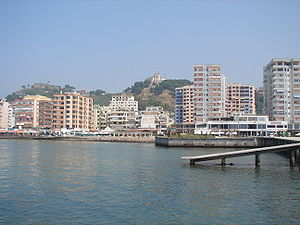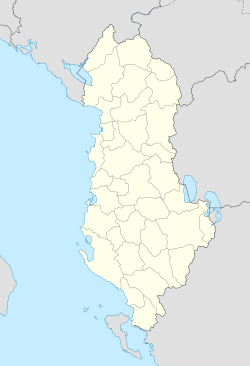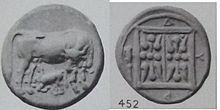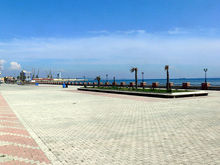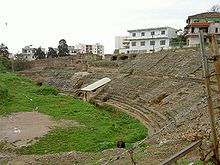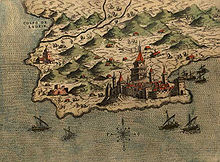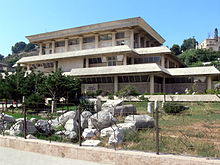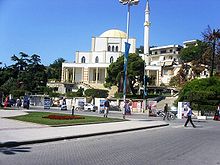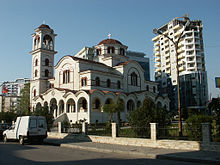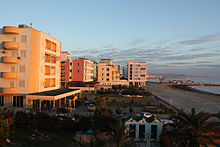- Durrës
-
"Dyrrhachium" redirects here. For any of three battles which occurred here, see Battle of Dyrrhachium (disambiguation).
Durrës — Municipality and City — 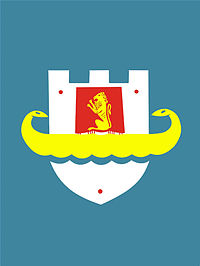
SealCoordinates: 41°19′N 19°27′E / 41.317°N 19.45°E Country  Albania
AlbaniaCounty Durrës County District Durrës District Regions (Rajone) 6 Founded 627 BC Government – Mayor Vangjush Dako (PS)[1] Elevation 0 ft (0 m) Population (2009[2]) – Total 203,550 Time zone Central European Time (UTC+1) – Summer (DST) CEST (UTC+2) Postal code 2001-2009 Area code(s) 052 Website www.durres.gov.al Durrës is the second largest city of Albania located on the central Albanian coast, about 33 km (21 mi) west of the capital Tirana. It is one of the most ancient and economically important cities of Albania. Durres is situated at one of the narrower points of the Adriatic Sea, opposite the Italian ports of Bari (300 km/186 mi away) and Brindisi (200 km/124 mi away). Durrës is home to Albania's main port, the Port of Durrës, and to the newest public university, the Aleksander Moisiu University. It has a population of around 202,000 (as of 2009[update] estimate). In addition, it is the meeting point of national roads SH2 and SH4. Founded in the 7th century BC by Greek colonists from Corinth and Corcyra, it has been continuously inhabited for 27 centuries and is one of the oldest cities in Albania.
Contents
Names
The city was known with its Greek names Epidamnus (Επίδαμνος) or Dyrrhachion (Δυρράχιον) in the classical and Roman antiquity. Roman authors believed that either she was renamed from Epidamnus to Dyrrachium because "damn" had a negative meaning in Latin or that she was named so after the hero Dyrrachius.[3] In other languages is known by derivatives of the name Dyrrachium, i.e. in Slavonic Drač (Драч), in Ottoman Turkish Dıraç and in Italian Durazzo. In the past few decades, the Albanian name of the city, Durrës (Durrësi), has gradually replaced the widespread use of the Italian name Durazzo. For other names by which Durrës is known, see other names of Durrës.
History
Ancient
Though surviving remains are minimal,[4] as one of the oldest cities in Europe, the city was founded as Epidamnos in the ancient region of Illyria in 627 BC by ancient Greek[5] colonists from Corinth and Corcyra, modern-day Corfu. The general vicinity of Epidamus was called Epidamnia.[6] The city's geographical position was highly advantageous, as it was situated around a natural rocky harbour which was surrounded by inland swamps and high cliffs on the seaward side, making the city very difficult to attack from either land or sea.
Epidamnos was noted for being a politically advanced society, prompting Aristotle[7] to praise its political system in controlling trade between the Greek colonists and the local barbarians. However, Corinth and Corcyra, each with a claim to be "mother city" (metropolis), quarreled over the city, helping to precipitate the Peloponnesian War in 431 BC as one of the most significant battles took place on the Durrës seaside. Epidamnos was seized by Glaukias, an Illyrian king, in 312 BC with the help of the local Greek oligarchy.[8] Later Queen Teuta attacked Epidamnos but withdrew when the Romans arrived the same year (229 BC) and expelled the Illyrian garrison from the city, including it thereafter in their protectorate. The Romans set up replaced the rule of Teuta with that of Demetrius of Pharos, one of her generals.[9] He lost his kingdom, including Epidamnus, to the Romans in 219 BC at the Second Illyrian War. In the Third Illyrian War Epidamnus was attacked by Gentius but he was defeated by the Romans[10] at the same year.
For Catullus, the city was Durrachium Hadriae tabernam, "the taberna of the Adriatic", one of the stopping places for a Roman traveling up the Adriatic, as Catullus had done himself in the sailing season of 56.[11]
Roman and Byzantine rule
After the Illyrian Wars with the Roman Republic in 229 BC ended in a decisive defeat for the Illyrians, the city passed to Roman rule, under which it was developed as a major military and naval base. The Romans renamed it Dyrrachium (Greek: Δυρράχιον / Dyrrhachion). They considered the name Epidamnos to be inauspicious because of its wholly coincidental similarities with the Latin word damnum, meaning "loss" or "harm". The meaning of Dyrrachium ("bad spine" or "difficult ridge" in Greek) is unclear, but it has been suggested that it refers to the imposing cliffs near the city. Julius Caesar's rival Pompey made a stand there in 48 BC before fleeing south to Greece. Under Roman rule, Dyrrachium prospered; it became the western end of the Via Egnatia, the great Roman road that led to Thessalonica and on to Constantinople. Another lesser road led south to the city of Buthrotum, the modern Butrint. The Roman emperor Caesar Augustus made the city a colony for veterans of his legions following the Battle of Actium, proclaiming it a civitas libera (free town).
In the 4th century AD, Dyrrachium was made the capital of the Roman province of Epirus nova. It was the birthplace of the emperor Anastasius I in circa 430. Some time later that century, Dyrrachium was struck by a powerful earthquake which destroyed the city's defences. Anastasius I rebuilt and strengthened the city walls, thus creating the strongest fortifications in the western Balkans. The 12 m (36 ft)-high walls were so thick that, according to the Byzantine historian Anna Komnene, four horsemen could ride abreast on them. Significant portions of the ancient city defences still remain, although they have been much reduced over the centuries.
Like much of the rest of the Balkans, Dyrrachium and the surrounding Dyrraciensis provinciae suffered considerably from barbarian incursions during the Migrations Period. It was besieged in 481 by Theodoric the Great, king of the Ostrogoths, and in subsequent centuries had to fend off frequent attacks by the Bulgarians. Unaffected by the fall of the Western Roman Empire, the city continued under the Byzantine Empire as an important port and a major link between the Empire and western Europe.
Middle Ages
The city and the surrounding coast became a Byzantine province (the Theme of Dyrrhachium) in the early 9th century. Byzantine rule was contested by the Bulgarians under Simeon the Great, but it remained in Byzantine hands until the late 10th century, when Samuel of Bulgaria conquered the city and held it until ca. 1005.
Dyrrachium was lost in February 1082 by the emperor Alexios I Komnenos to the Normans under Robert Guiscard and his son Bohemund in the Battle of Dyrrhachium. Byzantine control was restored a few years later but the city was lost again in 1185, this time to the Norman King William II of Sicily. In 1205, after the Fourth Crusade, the city was transferred to the rule of the Republic of Venice who formed the "Duchy of Durazzo". This Duchy was destroyed in 1213 and the city was taken by the Despotate of Epirus. In 1257 Durrës was briefly occupied by the King of Sicily, Manfred of Hohenstaufen. It was re-occupied by the Despote of Epirus Michael II until 1259 when the Despotate was defeated by the Byzantine Empire of Nicaea in the Battle of Pelagonia. In 1270's Durrës was again controlled by Nikephoros I Angelos, the son of Despot Michael II who in 1278 was forced to yield the city to Charles d' Anjou (Charles I of Sicily).
Five years later, in ca. 1273, it was wrecked by a devastating earthquake (according to George Pachymeres; R. Elsie, Early Albania (2003), p. 12) but soon recovered. It was briefly occupied by the King Milutin of Serbia in 1296. In early 14th century the city was under the rule of a coalition between Anjous, Hungarians and the Albanian rulers of the Thopia family. In 1317 or 1318 the area was taken by the Serbs and remained under their rule till 1350's. At that time the Popes, supported by the Anjous, increased their diplomatic and political activity in the area, by using the Latin bishops, including the archbishop of Durrës. The city had been the religious center of the Catholicism after the Anjou were installed in Durrës. In 1272 a Catholic archbishop was installed and till mid 14th c. a double line of Catholic and Orthodox archbishops of Durrës seem to exist.[12]
When the Serbian King (Tsar) Dušan, died in 1355, the city passed into the hands of the Albanian family of Thopias. The Republic of Venice regained control in 1392 and retained the city, known as Durazzo in those years, as part of the Albania Veneta. It fended off a siege by the Ottoman Sultan Mehmed II in 1466 but fell to Ottoman forces in 1501.Durrës became a Christian city quite early on; its bishopric was created around AD 58 and was raised to the status of an archbishopric in 449. It was also the seat of a Greek Orthodox metropolitan bishop. Under Turkish rule, many of its inhabitants converted to Islam and many mosques were erected. This city was renamed as Dıraç, the city did not prosper under the Ottomans and its importance declined greatly. By the mid-19th century, its population was said to have been only about 1,000 people living in some 200 households. Its decrepitude was noted by foreign observers in the early 20th century: "The walls are dilapidated; plane-trees grow on the gigantic ruins of its old Byzantine citadel; and its harbour, once equally commodious and safe, is gradually becoming silted up."[13] It was a sanjak centre in İşkodra Vilayet before 1912.
20th century
Durrës was an active city in the Albanian national liberation movement in the periods 1878-1881 and 1910-1912. Ismail Qemali raised the Albanian flag on November 26, 1912 but the city was captured by the Kingdom of Serbia three days later during the First Balkan War. On November 29, 1912 Durrës became the county town of the Durrës County (Serbian: Драчки округ) one of the counties of the Kingdom of Serbia established on the part of the territory of Albania occupied from Ottoman Empire. The Durrës County had four districts (Serbian: срез): Durres, Lezha, Elbasan and Tirana.[14] The army of the Kingdom of Serbia retreated from Durrës in April 1913.[15] The city became Albania's second national capital (after Vlora) on March 7, 1914 under the brief rule of Prince William of Wied.
During the First World War, the city was occupied by Italy in 1915 and by Austria-Hungary in 1916-1918. It was captured by the Allies in October 1918. Restored to Albanian sovereignty, Durrës became the country's temporary capital between 1918 and March 1920. It experienced an economic boom due to Italian investments and developed into a major seaport under the rule of King Zog, with a modern harbour being constructed in 1927.
An earthquake in 1926 damaged some of the city and the rebuilding that followed gave the city its more modern appearance. During the 1930s, the Bank of Athens had a branch in the city.
The Second World War saw Durrës (called Durazzo again in Italian) and the rest of Albania being annexed to the Kingdom of Italy between 1939–1943, then occupied by Nazi Germany until 1944. Durrës's strategic value as a seaport made it a high-profile military target for both sides. It was the site of the initial Italian landings on 7 April 1939 as well as the launch point for the ill-fated Italian invasion of Greece. The city was heavily damaged by Allied bombing during the war and the port installations were blown up by the retreating Germans in 1944.
The Communist regime of Enver Hoxha rapidly rebuilt the city following the war, establishing a variety of heavy industries in the area and expanding the port. It became the terminus of Albania's first railway, begun in 1947. In the late 1980s the city was briefly renamed Durrës-Enver Hoxha. The city was and continuous to remain the center of Albanian mass beach tourism.
Following the collapse of communist rule in 1990, Durrës became the focus of mass emigrations from Albania with ships being hijacked in the harbour and sailed at gunpoint to Italy. In one month alone, August 1991, over 20,000 people migrated to Italy in this fashion. Italy intervened militarily, putting the port area under its control, and the city became the center of the European Community's "Operation Pelican", a food-aid program.
In 1997, Albania slid into anarchy following the collapse of a massive pyramid scheme which devastated the national economy. An Italian-led peacekeeping force was controversially deployed to Durrës and other Albanian cities to restore order, although there were widespread suggestions that the real purpose of "Operation Alba" was to prevent economic refugees continuing to use Albania's ports as a route to migrate to Italy.
After the turn of the century, the city has witnessed a modest revival as many streets have been paved, parks revamped and facades painted.
Economy
Durrës is still an important link to Western Europe due to its port and its proximity to the Italian port cities, notably Bari, to which daily ferries run. As well as the dockyard, it also possesses an important shipyard and manufacturing industries, notably producing leather, plastic and tobacco products. The neighbouring district produce wine and a variety of foodstuffs.
Climate
Durrës has a typical Mediterranean climate with hot, dry summers and cool winters. The average of water temperature in Durrës is from 14 °C (57 °F) in February to 26 °C (79 °F) in August. The summer in Durrës starts from May to middle of October .
Climate data for Durrës Month Jan Feb Mar Apr May Jun Jul Aug Sep Oct Nov Dec Year Record high °C (°F) 19
(66)23
(73)23
(73)28
(82)34
(93)37
(99)39
(102)38
(100)33
(91)28
(82)26
(79)20
(68)39
(102)Average high °C (°F) 11
(52)12
(54)15
(59)18
(64)23
(73)28
(82)30
(86)30
(86)26
(79)22
(72)17
(63)12
(54)20.3
(68.6)Average low °C (°F) 4
(39)5
(41)8
(46)11
(52)15
(59)19
(66)21
(70)21
(70)17
(63)14
(57)10
(50)6
(43)12.6
(54.6)Record low °C (°F) −6
(21)−10
(14)−2
(28)0
(32)7
(45)9
(48)13
(55)11
(52)6
(43)5
(41)−2
(28)−2
(28)−10
(14)Precipitation mm (inches) 91
(3.58)103
(4.06)99
(3.9)83
(3.27)63
(2.48)50
(1.97)31
(1.22)43
(1.69)118
(4.65)80
(3.15)146
(5.75)140
(5.51)1,047
(41.22)Source: [16] Sights
 Bunkers, old and new buildings along Durrës beach
Bunkers, old and new buildings along Durrës beach
Some important buildings in Durrës include the main library, the cultural center with the Aleksander Moisiu theater, the Estrada Theater, the puppet theater, and the philharmonic orchestra. There are also several museums such as the Archaeological Museum, Ahmet Zogu's Villa of Durrës and the Museum of History.
The city's beaches are also a popular destination for many foreign and local tourists, with an estimated 600,000 tourists visiting annually. Many Albanians from Tirana and elsewhere spend their summer vacations on the beaches of Durrës.
The largest amphitheatre in the Balkans is located in the city close to the harbour. This first-century construction is currently under consideration for inscription as a UNESCO World Heritage site.[17][18]
International relations
See also: List of twin towns and sister cities in AlbaniaTwin towns — sister cities
Notable people
- Anastasius I (emperor), Emperor of the Byzantine Empire
- Leonik Tomeu, professor of Nicholas Copernicus at the University of Padova
- John Kukuzelis, famous Byzantine music composer
- Panajot Pano, famous soccer player.
- Abaz Efendi Çelkupa, signatory of the Albanian Declaration of Independence
- Mustafa Agë Hanxhiu, signatory of the Albanian Declaration of Independence
- Jahja Ballhysa, signatory of the Albanian Declaration of Independence
- Dom Nikollë Kaçorri, signatory of the Albanian Declaration of Independence
- Mirela Manjani, athlete
- Pëllumb Xhufi, historian and former Minister of Foreign Affairs
See also
- Battle of Dyrrhachium
- History of Albania
- List of ancient cities in Illyria
- List of cities in Albania
- List of traditional Greek place names
- Tourism in Albania
- Transport in Albania
- Rrok Mirdita
- Port of Durrës
- The Beauty of Durrës
References
- ^ Durrës.gov.al
- ^ Durrës.gov.al
- ^ Cassius Dio, Roman History, Book XLI, 49. English translation.
- ^ A selection of modern travelers' accounts and references in ancient literature are given in P. Cabanes and F. Drini, eds, Inscription d'Épidamne-Dyrrhachion et d'Apollonia, vol. I (1995)
- ^ Wilkes, J. J. The Illyrians, 1992, ISBN 0631198075, page 96,"From Bouthoe to Epidamnus, a Greek city, the ..."
- ^ James Augustus St. John, The History of the Manners and Customs of Ancient Greece volume 3 (reprinted 2003:275) ISBN 1402154410
- ^ Aristotle, Politics 2.1267b
- ^ P. J. Rhodes,, A History of the Classical Greek World, 478 - 323 BC (Blackwell History of the Ancient World) 2005:82: "... expelled the oligarchs, and the oligarchs joined with the neighbouring Taulantians in attacking Epidamnus..."
- ^ Wilkes, J. J. The Illyrians, 1992, p. 120, ISBN 0631198075, page 161, "... Gulf of Kotor. The Romans decided that enough had been achieved and hostilities ceased. The consuls handed over Illyria to Demetrius and withdrew the fleet and army to Epidamnus , ..."
- ^ John Drogo Montagu, Battles of the Greek and Roman Worlds: A Chronological Compendium of 667 Battles to 31BC, (series Historians of the Ancient World (Greenhill Historic Series), 2000:47 ISBN 1853673897.
- ^ M. Gwyn Morgan, "Catullus and the 'Annales Volusi'" Quaderni Urbinati di Cultura Classica, New Series, 4 (1980):59-67).
- ^ Etleva Lala (2008) Regnum Albaniae, the Papal Curia, and the Western Visions of a Borderline Nobility
- ^ [1][dead link]
- ^ Bogdanović, Dimitrije; Radovan Samardžić (1990). Knjiga o Kosovu: razgovori o Kosovu. Književne novine. p. 208. http://books.google.com/books?id=FbpBAAAAYAAJ&q=%D1%81%D1%80%D0%B5%D0%B7+%D0%B5%D0%BB%D0%B1%D0%B0%D1%81%D0%B0%D0%BD&dq=%D1%81%D1%80%D0%B5%D0%B7+%D0%B5%D0%BB%D0%B1%D0%B0%D1%81%D0%B0%D0%BD&hl=en&ei=rww4TsSYNNCp8QOD2-n1Ag&sa=X&oi=book_result&ct=result&resnum=1&ved=0CCgQ6AEwAA. Retrieved 2 August 2011. "На освојеном подручју су одмах успостављене грађанске власти и албанска територија је Де Факто анектирана Србији : 29. новембра је основан драчки округ са четири среза (Драч, Љеш, Елбасан, Тирана)....On conquered territory of Albania was established civil government and territory of Albania was de facto annexed by Serbia: On November 29 was established Durres County with four srez (Durres, Lezha, Elbasan and Tirana)"
- ^ Antić, Čedomir (January 2, 2010). "Kratko slavlje u Draču [Short celebration in Durres]" (in Serbian). Večernje novosti. http://www.novosti.rs/dodatni_sadrzaj/clanci.119.html:280057-Kratko-slavlje-u-Dracu. Retrieved 5 August 2011. "VeĆ u aprilu 1913. postalo je izvesno da je kraj "albanske operacije" blizu. Pod pritiskom flote velikih sila srpska vojska je napustila jadransko primorje. ...In April 1913 it became obvious that the "Albanian operation" is over. Under pressure of the fleet of Great Powers army of Serbia retreated from the Adriatic coast."
- ^ Myweather2.com
- ^ L'amphithéâtre de Durrës - UNESCO World Heritage Centre
- ^ Img580.imageshack.us
- ^ "Sister Cities of Istanbul". http://www.greatistanbul.com/sister_cities.htm. Retrieved 1 July 2009.
- ^ Erdem, Selim Efe (1 July 2009). "İstanbul'a 49 kardeş" (in Turkish). Radikal. http://www.radikal.com.tr/haber.php?haberno=94185. Retrieved 22 July 2009. "49 sister cities in 2003"
External links
- Durrës on Wikitravel
- Durrës on In Your Pocket City Guide
- Official Durres Guide
- Official Map of Durres
- Visit Durrës (Archived webpage)
- Municipality of Durrës (Albanian)
- Durrës International Film Summer Fest
- Durrës Port Authority
- Minibus departure times from/to Durrës
- Panoramic Photo of Durres in the 1920s
- Durrës Projet
- Explore Durrës Amphitheatre with Google Earth on Global Heritage Network
Coordinates: 41°19′N 19°27′E / 41.317°N 19.45°E
Cities in Albania Bajram Curri · Bajzë · Ballsh · Berat · Bilisht · Bulqizë · Burrel · Cërrik · Çorovodë · Delvinë · Divjakë · Durrës · Elbasan · Ersekë · Fier · Fushë-Arrëz · Fushë-Krujë · Gjirokastër · Gramsh · Himarë · Kamëz · Kavajë · Këlcyrë · Klos · Konispol · Koplik · Korçë · Krastë · Krrabë · Krujë · Krumë · Kuçovë · Kukës · Kurbnesh · Laç · Leskovik · Lezhë · Libohovë · Librazhd · Lushnjë · Maliq · Mamurras · Manëz · Memaliaj · Orikum · Patos · Peqin · Përmet · Peshkopi · Pogradec · Poliçan · Prrenjas · Pukë · Reps · Roskovec · Rrëshen · Rrogozhinë · Rubik · Sarandë · Selenicë · Shëngjin · Shijak · Shkodër · Sukth · Tepelenë · Tirana · Ulëz · Urë Vajgurore · Vau i Dejës · Vlorë · Vorë

Municipalities of Durrës County Capital: DurrësDurrës District 
Krujë District Durrës Landmarks Villa of Ahmet Zogu · Durrës Archaeological Museum · Durrës Amphitheatre · Currilat · Beach of Durrës · Durrës Castle · Rodoni Castle · Durrës Library · Aleksander Moisiu Theatre · Estrada Theatre · St. Anthony Church · Fatih Mosque · The Beauty of Durrës · Adriatik Hotel · Aleksandër Moisiu University of DurrësEvents Media Shijak TVTransport Oil fields Religious Cultural Monuments in Durrës County Durrës Church of Gjuricë · Fatih MosqueOther towns Basilica of Saint Michael, Arapaj · St. Anthony Church, Cape of Rodon · Bazaar Mosque, Krujë · Church ruins, Krujë · Teqe of Dollme, Krujë · St. Mary Church, Shën MëriCategories:- Cultural Monuments of Albania
- Durrës
- 620s BC establishments
- Ancient Greek cities
- Populated coastal places in Albania
- Populated places established in the 7th century BC
- Ancient Greek sites in Albania
- Mediterranean port cities and towns in Albania
- Greek colonies in Illyria
- Greek colonies in Albania
- Hellenistic Albania
Wikimedia Foundation. 2010.

